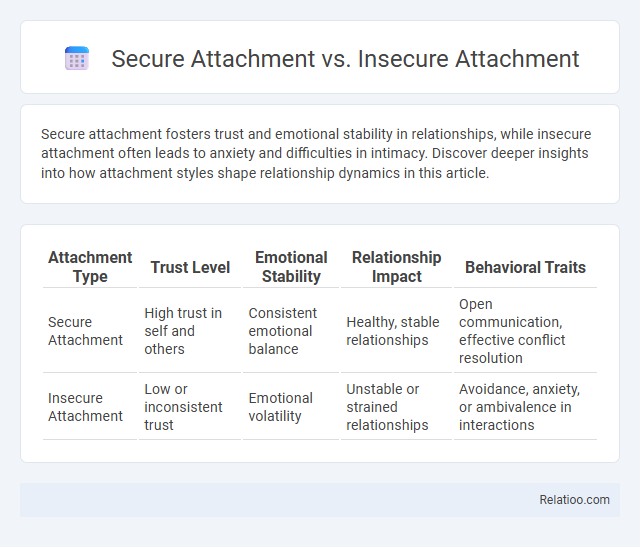Secure attachment fosters trust and emotional stability in relationships, while insecure attachment often leads to anxiety and difficulties in intimacy. Discover deeper insights into how attachment styles shape relationship dynamics in this article.
Table of Comparison
| Attachment Type | Trust Level | Emotional Stability | Relationship Impact | Behavioral Traits |
|---|---|---|---|---|
| Secure Attachment | High trust in self and others | Consistent emotional balance | Healthy, stable relationships | Open communication, effective conflict resolution |
| Insecure Attachment | Low or inconsistent trust | Emotional volatility | Unstable or strained relationships | Avoidance, anxiety, or ambivalence in interactions |
Understanding Attachment Theory
Secure attachment develops when caregivers consistently respond to a child's needs, fostering trust and emotional regulation. Insecure attachment occurs through inconsistent or neglectful caregiving, often resulting in anxiety, avoidance, or ambivalence in relationships. Understanding attachment theory provides critical insights into how early relational patterns influence emotional development and interpersonal dynamics across the lifespan.
Defining Secure Attachment
Secure attachment is characterized by trust and emotional safety, allowing individuals to form healthy, stable relationships with confidence in others' support. In contrast, insecure attachment often results from inconsistent or neglectful caregiving, leading to anxiety, mistrust, or avoidance in close bonds. Understanding secure attachment can help you foster stronger emotional connections and resilience in your personal relationships.
Characteristics of Secure Attachment
Secure attachment is characterized by trust, emotional availability, and effective communication between a child and caregiver, fostering resilience and healthy social development. In contrast, insecure attachment often involves anxiety, avoidance, or ambivalence, leading to challenges in relationships and emotional regulation. Understanding secure attachment's foundation in consistent responsiveness highlights its critical role in promoting psychological well-being.
Defining Insecure Attachment
Insecure attachment is characterized by inconsistent or unresponsive caregiving, leading to anxiety, mistrust, or avoidance in relationships. Unlike secure attachment, where individuals feel safe and supported, insecure attachment manifests in patterns such as anxious, avoidant, or disorganized behaviors. Understanding insecure attachment is crucial for addressing emotional difficulties and fostering healthier interpersonal connections.
Types of Insecure Attachment
Insecure attachment consists of three primary types: avoidant, ambivalent, and disorganized, each reflecting different behavioral patterns in relationships stemming from inconsistent caregiving. Avoidant attachment leads to emotional distancing and difficulty trusting others, while ambivalent attachment results in clinginess and anxiety over abandonment. Disorganized attachment combines fear and confusion, often linked to trauma, significantly impacting Your ability to form stable and secure connections.
Key Differences: Secure vs. Insecure Attachment
Secure attachment develops when caregivers consistently respond to a child's needs, fostering trust and emotional safety, while insecure attachment arises from inconsistent or neglectful caregiving, leading to anxiety or avoidance in relationships. Securely attached individuals tend to have healthier social interactions and better emotional regulation, whereas those with insecure attachment may experience difficulties with intimacy and emotional expression. Understanding these key differences is crucial for addressing attachment-related issues in therapeutic and developmental contexts.
Impact on Emotional Development
Secure attachment fosters healthy emotional development by promoting trust, empathy, and resilience, enabling you to form stable and supportive relationships. Insecure attachment, including anxious or avoidant types, can hinder emotional regulation, leading to difficulties in managing stress and understanding others' emotions. Attachment quality during early childhood critically shapes your emotional well-being and interpersonal skills throughout life.
How Parenting Styles Affect Attachment
Parenting styles significantly influence your child's attachment development, with secure attachment often fostered through consistent, responsive caregiving that meets emotional and physical needs. Insecure attachment may arise from neglectful, inconsistent, or overly harsh parenting, leading to anxiety, avoidance, or ambivalence in relationships. Understanding how authoritative (secure), authoritarian, permissive, and neglectful parental behaviors shape attachment can help improve your child's emotional resilience and interpersonal connections.
Long-Term Effects on Relationships
Secure attachment fosters trust, emotional intimacy, and effective communication, leading to healthier, more stable long-term relationships. Insecure attachment, including anxious or avoidant styles, often results in difficulties with trust, emotional regulation, and conflict resolution, increasing the risk of relationship instability or dissatisfaction. Understanding your attachment style is crucial for improving relationship dynamics and fostering lasting emotional bonds.
Strategies to Foster Secure Attachment
Fostering secure attachment involves consistent responsiveness to a child's emotional needs, creating a reliable and safe environment that builds trust and emotional regulation. Engaging in sensitive caregiving practices, such as maintaining eye contact, providing comfort during distress, and encouraging exploration while remaining available, promotes secure attachment. In contrast, insecure attachment often results from neglectful or unpredictable responses, highlighting the importance of stable and nurturing interactions for healthy emotional development.

Infographic: Secure Attachment vs Insecure Attachment
 relatioo.com
relatioo.com